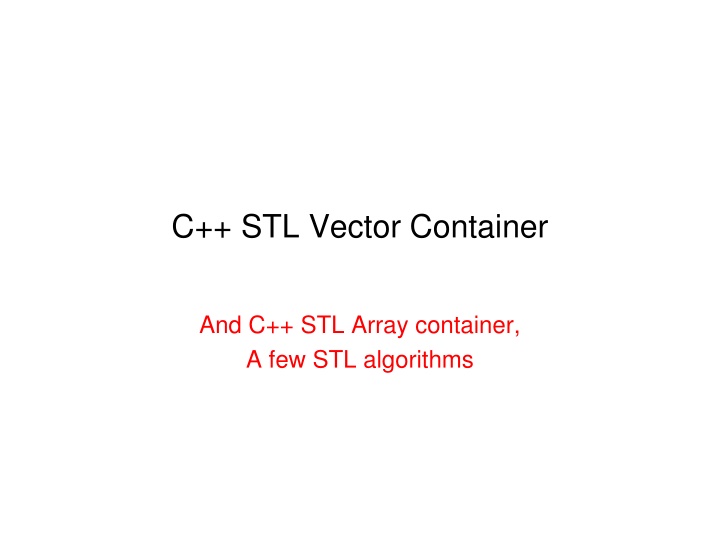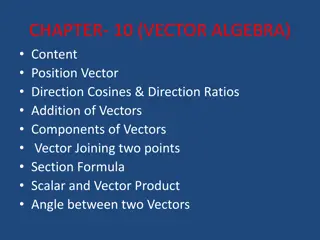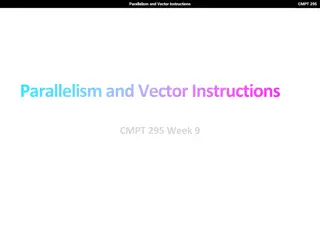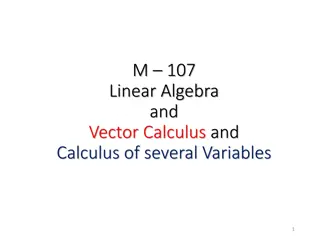C++ STL Vector Container
This content provides an overview of C++ STL vector and array containers along with key member functions and essential operations. Additionally, it covers the utilization of algorithms, compilation instructions, word puzzles, and the introduction of the C++11 array container. The included visuals offer a comprehensive guide on utilizing these containers efficiently.
Download Presentation

Please find below an Image/Link to download the presentation.
The content on the website is provided AS IS for your information and personal use only. It may not be sold, licensed, or shared on other websites without obtaining consent from the author.If you encounter any issues during the download, it is possible that the publisher has removed the file from their server.
You are allowed to download the files provided on this website for personal or commercial use, subject to the condition that they are used lawfully. All files are the property of their respective owners.
The content on the website is provided AS IS for your information and personal use only. It may not be sold, licensed, or shared on other websites without obtaining consent from the author.
E N D
Presentation Transcript
C++ STL Vector Container And C++ STL Array container, A few STL algorithms
STL Vector Container Header file <vector> Important member functions begin() and end(): return iterators clear(): delete all elements push_back(): insert at end pop_back(): delete last element size(): number of elements empty(): if vector is empty resize(): change vector size 2
Maximum and Average Values See max_avg.txt and max_avg.cpp To compile: make max_avg.x In general, in order to compile a program with name.cpp, you can type: make name.x, due to the way we write our makefile 3
Word Puzzle Problem description word_puzzle.pdf Section 1.1 in textbook Key question How to maintain word list (dictionary) Throughout the semester, we will show a number of different solutions using different containers Find the words in the puzzle, given a 2-D array and a word-list. 4
Word Puzzle Explaining the source code word_puzzle_vector.h, word_puzzle_vector.cpp Pay attention to the use of I/O streams, stringstreams, strings, and vector To compile: make 5
C++ STL Array Container New in C++11 Similar to array in C/C++ in that Array has fixed size memory Will not grow or shrink like other containers such as Vector Support similar interfaces as other containers But with notable difference (see next slide) Likely more efficient than Vector Use vector if you need to grow or shrink container Use vector if you are not sure 6
STL Array Container Header file <array> template < class T, size_t N > class array; Important member functions begin(), end(), for iterator support size(), max_size(), size of array empty(), test if size of array is zero Index operator[], at(), access element at specified position front(), back(), refer to first and last element, respectively data(), return a pointer to internal data (C/C++ pointer) fill(), set all elements in array to the specified value 7
STL Array Container See array_sort.cpp To compile: make array_sort.x Copy is an STL algorithm in <algorithm> http://www.cplusplus.com/reference/algorithm/copy/ Similarly, sort is an STL algorithm http://www.cplusplus.com/reference/algorithm/sort/ Note also the behavior of size(), max_size(), and fill() 8
STL Algorithm sort() Function signature void sort(RandomAccessIterator first, RandomAccessIterator last); void sort(RandomAccessIterator first, RandomAccessIterator last, Compare comp); Sort elements in the range [first, last) Note that containers must be random access containers The first version using operator<() overloaded for the corresponding data type The second version using function object of type Compare You can also use function or lambda function Function objects and lambda functions discussed in next few slides http://www.cplusplus.com/reference/algorithm/sort/ 9
Using Regular Function with Sort() You can use regular function to compare elements in container to be sorted See r3/example5.c 10
Function Objects (Functors) Objects whose primary purpose is to define a function To be passed into another function, such as sort() Read Section 1.6.4 in the textbook Review lecture notes ch1_cpptemplate.pptx http://www.cplusplus.com/reference/functional/ Compared to function (and lambda function), functors have the advantages that you can configure the comparison, for example, you only want to compare elements within certain range, which can be specified by the member variables of functors 11
Function Objects Using function objects with the sort() function See r3/example2.cpp 12
Lambda or Unnamed Functions Since C++2011 Similar to regular function, but you do not pre-define it, instead, you specify it on the function call (for example, sort()) It does not have a function name https://msdn.microsoft.com/en-us/library/dd293608.aspx See r3/example4.cpp 13
STL Algorithm find() Function signature InputIterator find (InputIterator first, InputIterator last, const T& val); Search val in the range [first, last) Return iterator to first appearance of val in the range Return last if not found in the range http://www.cplusplus.com/reference/algorithm/find/ See examples/r3/example1.cpp 14
STL Algorithm max_element() Function signature ForwardIterator max_element(ForwardIterator first, ForwardIterator last); ForwardIterator max_element(ForwardIterator first, ForwardIterator last, Compare comp); Return largest value in the range [first, last) The first version using operator<() overloaded for the corresponding data type The second version using function object of type Compare You can also use lambda function for the comparison http://www.cplusplus.com/reference/algorithm/max_element/ See r3/example3.cpp 15























